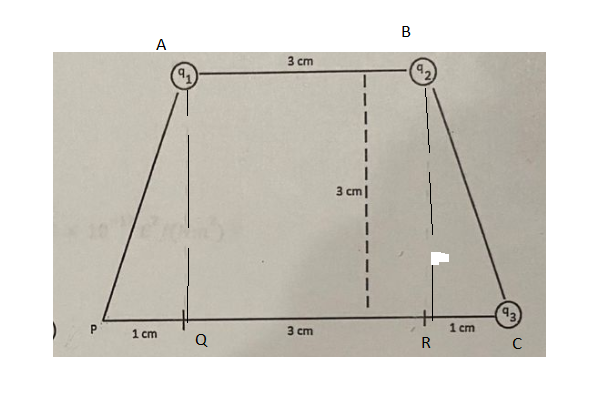2. Three point charges are fixed in place at the corners of a trapezoid as shown. The upper side has length 3.0 cm, the base has length 5.0 cm and the height is 3.0 cm. q, =+ 10.0 nC, 3 cm =- 5.0 nC, and 93 =+ 5.0 nC. 92 a. Find the electric field at point P, the lower left corner of the trapezoid. b. Find the electric potential at point P taking the potential at infinity to be zero. 3 cm| -27 = 1. 67 x 10 "kg) 1 cm c. Suppose a proton (m is placed at point P and is released from rest. What will its speed be when it is very far from the arrangement of charges? 1 cm 3 cm
2. Three point charges are fixed in place at the corners of a trapezoid as shown. The upper side has length 3.0 cm, the base has length 5.0 cm and the height is 3.0 cm. q, =+ 10.0 nC, 3 cm =- 5.0 nC, and 93 =+ 5.0 nC. 92 a. Find the electric field at point P, the lower left corner of the trapezoid. b. Find the electric potential at point P taking the potential at infinity to be zero. 3 cm| -27 = 1. 67 x 10 "kg) 1 cm c. Suppose a proton (m is placed at point P and is released from rest. What will its speed be when it is very far from the arrangement of charges? 1 cm 3 cm
Related questions
Question

Transcribed Image Text:**Problem 2: Electric Charge Configuration**
Three point charges are fixed in place at the corners of a trapezoid as shown. The upper side has length 3.0 cm, the base has length 5.0 cm, and the height is 3.0 cm. The charges are as follows:
- \( q_1 = +10.0 \, \text{nC} \)
- \( q_2 = -5.0 \, \text{nC} \)
- \( q_3 = +5.0 \, \text{nC} \)
Questions:
a. **Electric Field at Point P**
Find the electric field at point P, the lower left corner of the trapezoid.
b. **Electric Potential at Point P**
Find the electric potential at point P, taking the potential at infinity to be zero.
c. **Motion of a Proton**
Suppose a proton (\( m = 1.67 \times 10^{-27} \, \text{kg} \)) is placed at point P and is released from rest. What will its speed be when it is very far from the arrangement of charges?
**Diagram Explanation:**
- The diagram depicts a trapezoid with point charges at each corner.
- \( q_1 \) and \( q_2 \) are located at the top corners, each 3 cm apart.
- \( q_3 \) is at the bottom right corner, 1 cm from the base's end, making the base 5 cm long.
- Point P is located at the lower left corner of the trapezoid, 1 cm from \( q_1 \).
This problem requires understanding concepts of electric fields and potentials in the context of a multiple-charge system.
Expert Solution
Step 1
Given:
Length of upper side of the trapezoid
Length of the base of the trapezoid
Height of the trapezoid
Calculation:
(a) The electric field at point P is calculated as follows.
Let us first of all redraw the given figure in a simple way.

Step by step
Solved in 3 steps with 1 images
